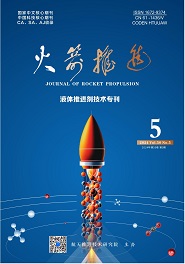航天推进技术研究院主办
YANG Zhenyu,LU Haifeng,FAN Wei,et al.Multi-fluid simulation of the magnetoplasma rocket engine[J].Journal of Rocket Propulsion,2024,50(02):57-66.[doi:10.3969/j.issn.1672-9374.2024.02.006]
磁等离子体发动机的多流体模拟
- Title:
- Multi-fluid simulation of the magnetoplasma rocket engine
- 文章编号:
- 1672-9374202402-0057-10
- Keywords:
- magnetoplasma rocket engine; helicon plasma source; ion cyclotron resonance heating; power coupling; fluid simulation
- 分类号:
- V439+.1
- 文献标志码:
- A
- 摘要:
- 磁等离子体发动机(magnetoplasma rocket engine,MPRE)的离子回旋共振加热(ion cyclotron resonance heating,ICRH)单元将射频能量直接耦合给离子,是发动机的工质加热单元,其加热效果对发动机推力性能有关键影响。为探究ICRH单元的工作规律,建立了用于模拟MPRE的二维轴对称多流体模型,并采用该模型对MPRE中螺旋波等离子体源与不同输入的ICRH单元进行了模拟。计算结果表明:螺旋波等离子体源在放电过程中由于沉积功率分布发生变化而不断经历模式转变过程,模式转变时电子温度出现峰值,等离子体密度迅速上升; 开启ICRH输入后,电子参数基本不变,离子温度有明显提升,表明ICRH单元对离子有明显加热效果,且增加输入电流幅值与输入电流匝数均可显著提高离子温度,实现发动机高比冲工作模式。
- Abstract:
- The Ion Cyclotron Resonance Heating(ICRH)stage is the RF-booster of the Magnetoplasma Rocket Engine(MPRE)in which the RF power is directly coupled to ions. The heating effect of the ICRH stage has an important influence on the thrust performance of the engine. A multi-fluid, two-dimensional, axisymmetric model was developed to study the heating effect of ICRH stage and the helicon plasma source of MPRE together with the ICRH stage of different input parameters were simulated. The results show that the operation mode of helicon plasma source changes continuously during the discharge due to the evolution of the the deposited power. The mode conversions are accompanied by the electron temperature peaks and the plasma density rises dramatically. After the ICRH input is turned on, the electron parameters are basically unchanged while the ion temperature increases significantly, which indicates the ICRH stage has an obvious heating effect on the ions and the ion temperature increases with the amplitude and the turns of the ICRH input current.
参考文献/References:
[1] 于达仁, 乔磊, 蒋文嘉, 等. 中国电推进技术发展及展望[J]. 推进技术, 2020, 41(1): 1-11.
YU D R, QIAO L, JIANG W J, et al. Development and prospect of electric propulsion technology in China[J]. Journal of Propulsion Technology, 2020, 41(1): 1-11.
[2]任军学, 刘宇, 王一白. 可变比冲磁等离子体火箭原理与研究进展[J]. 火箭推进, 2007, 33(3): 36-42.
REN J X, LIU Y, WANG Y B. Principle and research progress of variable specific impulse magnetoplasma rocket[J]. Journal of Rocket Propulsion, 2007, 33(3): 36-42.
[3]CHANG F R, FISHER J L. A supersonic gas target for a bundle divertor plasma[J]. Nuclear Fusion, 1982, 22(8): 1003-1013.
[4]DÍAZ F R C. Research status of the variable specific impulse magnetoplasma rocket[J]. Fusion Technology, 1999, 35(1): 87-93.
[5]BERING E, BRUKARDT M, SQUIRE J, et al. Recent improvements in ionization costs and ion cyclotron heating efficiency in the VASMIR engine[C]//44th AIAA Aerospace Sciences Meeting and Exhibit. Reston, Virginia: AIAA, 2006.
[6]BERING E A, DÍAZ F R C, SQUIRE J P, et al. Observations of single-pass ion cyclotron heating in a trans-sonic flowing plasma[J]. Physics of Plasmas, 2010, 17(4): 043509.
[7]BERING E A, GIAMBUSSO M, CARTER M, et al. Using VASIMR for the proposed Europa mission[C]//AIAA SPACE 2014 Conference and Exposition. Reston, Virginia: AIAA, 2014.
[8]BERING E, LONGMIER B, SQUIRE J, et al. Performance measurements and technology demonstration of the VASIMR VX-200[C]//AIAA SPACE 2010 Conference & Exposition. Reston, Virginia: AIAA, 2010.
[9]SQUIRE J P, CARTER M D, FRANKLIN R. Advances in duration testing of the VASIMR VX-200SS system[C]//52nd AIAA/SAE/ASEE Joint Propulsion Conference.USA:Salt Lake City, 2016.
[10]GIAMBUSSO M, CARTER M D, SQUIRE J P. Progress in VASIMR VX-200SS plasma testing program[C]//53rd AIAA/SAE/ASEE Joint Propulsion Conference.Reston, Virginia: AIAA, 2017.
[11]SQUIRE J P, CARTER M, DIAZ F C, et al. Run-time accumulation testing of the 100 kW VASIMR VX-200SS device[C]//2018 Joint Propulsion Conference. Reston, Virginia: AIAA, 2018.
[12]SQUIRE J P, CARTER M, CHANG DIAZ F R, et al. Steady-state testing at 100 kW in the VASIMR VX-200SS project[C]//AIAA Propulsion and Energy 2019 Forum. Reston, Virginia: AIAA, 2019.
[13]DÍAZ F R C, GIAMBUSSO M, CORRIGAN A M C. Recent progress on the VASIMR engine[C]//37th International Electric Propulsion Conference. USA: Cambridge, 2022.
[14]杨振宇, 曹亚文, 范威, 等. 磁等离子体发动机中离子回旋共振天线参数优化[J]. 推进技术, 2022, 43(4): 417-426.
YANG Z Y, CAO Y W, FAN W, et al. Parameter optimization of ion cyclotron resonance antenna in magnetoplasma rocket engine[J]. Journal of Propulsion Technology, 2022, 43(4): 417-426.
[15]孙斌, 赵杨, 魏建国, 等. 高功率螺旋波等离子体诊断试验研究[J]. 推进技术, 2019, 40(3): 707-713.
SUN B, ZHAO Y, WEI J G, et al. Plasma diagnostics of a high power Helicon source[J]. Journal of Propulsion Technology, 2019, 40(3): 707-713.
[16]BREIZMAN B N, AREFIEV A V. Single-pass ion cyclotron resonance absorption[J]. Physics of Plasmas, 2001, 8(3): 907-915.
[17]ILIN A, DIAZ F C, SQUIRE J, et al. Plasma heating simulation in the VASIMR system[C]//43rd AIAA Aerospace Sciences Meeting and Exhibit. Reston, Virginia: AIAA, 2005.
[18]ILIN A V, CHANG DÍAZ F R, SQUIRE J P, et al. Improved simulation of the ICRF waves in the VASIMR plasma[J]. Computer Physics Communications, 2004, 164(1/2/3): 251-257.
[19]VENTZEK P L G, HOEKSTRA R J, KUSHNER M J. Two-dimensional modeling of high plasma density inductively coupled sources for materials processing[J]. Journal of Vacuum Science & Technology B: Microelectronics and Nanometer Structures Processing, Measurement, and Phenomena, 1994, 12(1): 461-477.
[20]吴明阳.电推进中螺旋波放电和离子回旋共振能化的研究[D].北京: 北京大学, 2021.
[21]NAMIKI T. A new FDTD algorithm based on alternating-direction implicit method[J]. IEEE Transactions on Microwave Theory Techniques, 1999, 47(10): 2003-2007.
[22]ZHEN F H, CHEN Z Z, ZHANG J Z. Toward the development of a three-dimensional unconditionally stable finite-difference time-domain method[J]. IEEE Transactions on Microwave Theory and Techniques, 2000, 48(9): 1550-1558.
[23]赵转转. 感性耦合放电中离子能量和角度分布的数值模拟研究[D]. 大连: 大连理工大学, 2019.
ZHAO Z Z. Numerical simulation of ion energy and angle distribution in inductively coupled discharge[D].Dalian: Dalian University of Technology, 2019.
[24]BORIS J P. LCPFCT: a flux-corrected transport algorithm for solving generalized continuity equations [R]. Washington D C: NRL, 1993.
[25]ELLINGBOE A R, BOSWELL R W. Capacitive, inductive and helicon-wave modes of operation of a Helicon plasma source[J]. Physics of Plasmas, 1996, 3(7): 2797-2804.
[26]SHAMRAI K P, TARANOV V B. Volume and surface rf power absorption in a Helicon plasma source[J]. Plasma Sources Science and Technology, 1996, 5(3): 474-491.
备注/Memo
收稿日期:2023- 05- 05 修回日期:2023- 06- 07
作者简介:杨振宇(1994—),男,博士,研究领域为空间电推进技术。
